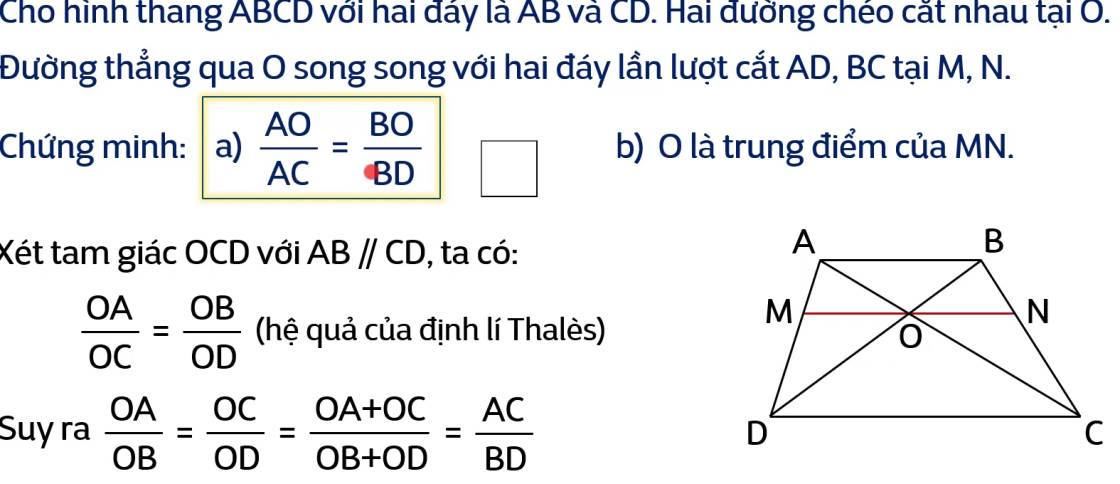
em vẫn không hiểu chỗ này lắm ạ có ai giải thích cho em hiểu tại sao AC/BD lại bằng OA/OB và có tỉ số 
Hãy nhập câu hỏi của bạn vào đây, nếu là tài khoản VIP, bạn sẽ được ưu tiên trả lời.

Bước 1: Tìm số hạng tổng quát của mỗi cấp số nhân
Số hạng tổng quát:
aₙ = a₁ * r₁^(n-1) = 1 * 1.51^(n-1)Số hạng tổng quát:
aₙ = a₁ * r₂^(n-1) = 1 * 2.52^(n-1)Bước 2: Tính tổng n số hạng đầu tiên của mỗi cấp số nhân
Bước 3: Đặt S₁ = S₂ và giải phương trình
1 * (1 - 1.51^n) / (1 - 1.51) = 1 * (1 - 2.52^n) / (1 - 2.52) (1 - 1.51^n) / (1 - 1.51) = (1 - 2.52^n) / (1 - 2.52)Nhân chéo:
(1 - 1.51^n) * (1 - 2.52) = (1 - 2.52^n) * (1 - 1.51) 1 - 2.52 + 2.52 * 1.51^n = 1 - 1.51 + 1.51 * 2.52^n 1.51 * 2.52^n - 1.51 * 1.51^n = 1 - 2.52 1.51^n * (2.52 - 1.51) = 1 - 2.52 1.51^n = (1 - 2.52) / (2.52 - 1.51) 1.51^n = -1.52 / 1.01Lấy logarit cơ số 1.51 của cả hai vế:
n * log₁.₅₁(-1.52 / 1.01) = log₁.₅₁(-1.52 / 1.01) n = log₁.₅₁(-1.52 / 1.01) / log₁.₅₁(-1.52 / 1.01) n = 1Vậy, n = 1.

(2x - 1)/3 -(x +2)/6 =5
2(2x - 1)/6 - (x+2)/6 = (5 .6)/6
4x -2 -x -2 = 30
3x = 34
x = 34/3

Đường thẳng y=x-4 có a=1>0
nên đường thẳng y=x-4 tạo với trục Ox một góc nhọn có số đo là:
\(arctan\left(1\right)=45^0\)

a: Xét ΔABC vuông tại A và ΔHAC vuông tại H có
\(\widehat{ACB}\) chung
Do đó: ΔABC~ΔHAC
b: ΔABC vuông tại A
=>\(AB^2+AC^2=BC^2\)
=>\(AC=\sqrt{10^2-8^2}=6\left(cm\right)\)
ΔABC~ΔHAC
=>\(\dfrac{CA}{CH}=\dfrac{CB}{CA}\)
=>\(CA^2=CH\cdot CB\)
=>\(CH\cdot10=36\)
=>CH=36/10=3,6(cm)
ta có: HB+HC=BC
=>HB+3,6=10
=>HB=6,4(cm)

\(\dfrac{x+1}{2024}+\dfrac{x+2}{2023}=\dfrac{x+3}{2022}+\dfrac{x+4}{2021}\)
=>\(\left(\dfrac{x+1}{2024}+1\right)+\left(\dfrac{x+2}{2023}+1\right)=\left(\dfrac{x+3}{2022}+1\right)+\left(\dfrac{x+4}{2021}+1\right)\)
=>\(\dfrac{x+2025}{2024}+\dfrac{x+2025}{2023}=\dfrac{x+2025}{2022}+\dfrac{x+2025}{2021}\)
=>\(\left(x+2025\right)\left(\dfrac{1}{2024}+\dfrac{1}{2023}-\dfrac{1}{2022}-\dfrac{1}{2021}\right)=0\)
=>x+2025=0
=>x=-2025

a: Xét ΔABC vuông tại A và ΔHAC vuông tại H có
\(\widehat{ACB}\) chung
Do đó: ΔABC~ΔHAC
Xét ΔHAB vuông tại H và ΔHCA vuông tại H có
\(\widehat{HAB}=\widehat{HCA}\left(=90^0-\widehat{ABC}\right)\)
Do đó: ΔHAB~ΔHCA
=>\(\dfrac{HA}{HC}=\dfrac{HB}{HA}\)
=>\(HA^2=HB\cdot HC\)
b: Xét ΔEAB vuông tại A và ΔEFC vuông tại F có
\(\widehat{AEB}=\widehat{FEC}\)(hai góc đối đỉnh)
Do đó: ΔEAB~ΔEFC
=>\(\dfrac{EA}{EF}=\dfrac{EB}{EC}\)
=>\(EA\cdot EC=EB\cdot EF\)

a: Xét ΔHBA vuông tại H và ΔABC vuông tại A có
\(\widehat{HBA}\) chung
Do đó: ΔHBA~ΔABC
=>\(\dfrac{AB}{BC}=\dfrac{HA}{AC}\)
=>\(AB\cdot AC=HA\cdot BC\)
b: Xét ΔAMH vuông tại M và ΔAHB vuông tại H có
\(\widehat{MAH}\) chung
Do đó: ΔAMH~ΔAHB
=>\(\dfrac{AM}{AH}=\dfrac{AH}{AB}\)
=>\(AH^2=AM\cdot AB\left(1\right)\)
Xét ΔANH vuông tại N và ΔAHC vuông tại H có
\(\widehat{NAH}\) chung
Do đó: ΔANH~ΔAHC
=>\(\dfrac{AN}{AH}=\dfrac{AH}{AC}\)
=>\(AN\cdot AC=AH^2\left(2\right)\)
Từ (1),(2) suy ra \(AM\cdot AB=AN\cdot AC\)
=>\(\dfrac{AM}{AC}=\dfrac{AN}{AB}\)
Xét ΔAMN vuông tạiA và ΔACB vuông tại A có
\(\dfrac{AM}{AC}=\dfrac{AN}{AB}\)
Do đó: ΔAMN~ΔACB
c:
ΔABC vuông tại A
=>\(AB^2+AC^2=BC^2\)
=>\(BC=\sqrt{6^2+8^2}=10\left(cm\right)\)
\(AH\cdot BC=AB\cdot AC\)
=>\(AH\cdot10=6\cdot8=48\)
=>AH=48/10=4,8(cm)
ΔABC vuông tại A
=>\(S_{ABC}=\dfrac{1}{2}\cdot AB\cdot AC=\dfrac{1}{2}\cdot6\cdot8=24\left(cm^2\right)\)
Xét tứ giác AMHN có \(\widehat{AMH}=\widehat{ANH}=\widehat{MAN}=90^0\)
nên AMHN là hình chữ nhật
=>MN=AH
mà AH=4,8cm
nên MN=4,8(cm)
ΔAMN~ΔACB
=>\(\dfrac{S_{AMN}}{S_{ACB}}=\left(\dfrac{MN}{CB}\right)^2=\left(\dfrac{4.8}{10}\right)^2\)
=>\(S_{AMN}=\left(\dfrac{4.8}{10}\right)^2\cdot24=5,5296\left(cm^2\right)\)
\(S_{AMN}+S_{BMNC}=S_{ABC}\)
=>\(S_{BMNC}=24-5,5296=18,4704\left(cm^2\right)\)

`#3107.101107`
`a)`
`5 - (x - 6) = 4(2x - 3)`
\(\Leftrightarrow5-x+6=8x-12\)
\(\Leftrightarrow-x-8x=-12-5-6\)
\(\Leftrightarrow-9x=-23\)
\(\Leftrightarrow x=\dfrac{-23}{-9}=\dfrac{23}{9}\)
Vậy, \(x=\dfrac{23}{9}\)
`b)`
\(5\left(3x+2\right)-4\left(5-3x\right)=1\)
\(\Leftrightarrow15x+10-20+12x=1\)
\(\Leftrightarrow27x-10=1\)
\(\Leftrightarrow27x=11\)
\(\Leftrightarrow x=\dfrac{11}{27}\)
Vậy, \(x=\dfrac{11}{27}\)
`c)`
\(-4\left(x-3\right)=6x+\left(x-3\right)\)
\(\Leftrightarrow-4x+12=6x+x-3\)
\(\Leftrightarrow-4x-7x=-12-3\)
\(\Leftrightarrow11x=-15\)
\(\Leftrightarrow x=\dfrac{-15}{11}\)
Vậy, \(x=-\dfrac{15}{11}\)
`d)`
\(\dfrac{x}{3}-\dfrac{5x}{6}-\dfrac{5x}{12}=\dfrac{x}{4}-5\)
\(\Leftrightarrow\dfrac{4x}{12}-\dfrac{10x}{12}-\dfrac{5x}{12}=\dfrac{3x}{12}-\dfrac{60}{12}\)
\(\Leftrightarrow4x-10x-5x=3x-60\)
\(\Leftrightarrow-11x-3x=-60\)
\(\Leftrightarrow-14x=-60\)
\(\Leftrightarrow x=\dfrac{-60}{-14}=\dfrac{30}{7}\)
Vậy, \(x=\dfrac{30}{7}\)
`e)`
\(\dfrac{x-1}{2}-\dfrac{x+1}{15}-\dfrac{2x-13}{6}=0\)
\(\Leftrightarrow\dfrac{15\left(x-1\right)}{30}-\dfrac{2\left(x+1\right)}{30}-\dfrac{5\left(2x-13\right)}{30}=0\)
\(\Leftrightarrow15\left(x-1\right)-2\left(x+1\right)-5\left(2x-13\right)=0\)
\(\Leftrightarrow15x-15-2x-2-10x+65=0\)
\(\Leftrightarrow3x+48=0\)
\(\Leftrightarrow3x=-48\)
\(\Leftrightarrow x=-16\)
Vậy, \(x=-16.\)
`f)`
\(\dfrac{3\left(3-x\right)}{8}+\dfrac{2\left(5-x\right)}{3}=\dfrac{1-x}{2}-2\)
\(\Leftrightarrow\dfrac{9\left(3-x\right)}{24}+\dfrac{16\left(5-x\right)}{24}=\dfrac{12\left(1-x\right)}{24}-\dfrac{48}{24}\)
\(\Leftrightarrow27-9x+80-16x=12-12x-48\)
\(\Leftrightarrow-9x-16x+12x=12-48-27-80\)
\(\Leftrightarrow-13x=-143\)
\(\Leftrightarrow x=11\)
Vậy, `x = 11.`
`g)`
\(\dfrac{3\left(5x-2\right)}{4}-2=\dfrac{7x}{3}-5\left(x-7\right)\)
\(\Leftrightarrow\dfrac{9\left(5x-2\right)}{12}-\dfrac{24}{12}=\dfrac{28x}{12}-\dfrac{60\left(x-7\right)}{12}\)
\(\Leftrightarrow45x-18-24=28x-60x+420\)
\(\Leftrightarrow45x-28x+60x=42+420\)
\(\Leftrightarrow77x=462\)
\(\Leftrightarrow x=6\)
Vậy, `x = 6`
`h)`
\(\dfrac{x+5}{2}+\dfrac{3-2x}{4}=x-\dfrac{7+x}{6}\)
\(\Leftrightarrow\dfrac{6\left(x+5\right)}{12}+\dfrac{3\left(3-2x\right)}{12}=\dfrac{12x}{12}-\dfrac{2\left(7+x\right)}{12}\)
\(\Leftrightarrow6x+30+9-6x=12x-14-2x\)
\(\Leftrightarrow-10x=-53\)
\(\Leftrightarrow x=5,3\)
Vậy, `x = 5,3`
`i)`
\(\dfrac{x-3}{11}+\dfrac{x+1}{3}=\dfrac{x+7}{9}-1\)
\(\Leftrightarrow\dfrac{9\left(x-3\right)}{99}+\dfrac{33\left(x+1\right)}{99}=\dfrac{11\left(x+7\right)}{99}-\dfrac{99}{99}\)
\(\Leftrightarrow9x-27+33x+33=11x+77-99\)
\(\Leftrightarrow42x-11x=-22-6\)
\(\Leftrightarrow31x=-28\)
\(\Leftrightarrow x=-\dfrac{28}{31}\)
Vậy, \(x=-\dfrac{28}{31}.\)

a: 5+2x=20-3x
=>2x+3x=20-5
=>3x=15
=>\(x=\dfrac{15}{3}=5\)
b: \(7-\left(2x+4\right)=-\left(x+4\right)\)
=>\(7-2x-4+x+4=0\)
=>7-x=0
=>x=7
c: \(\left(5x+2\right)-3\left(2x+1\right)=-3x+7\)
=>\(5x+2-6x-3=-3x+7\)
=>-3x+7=-x-1
=>-2x=-8
=>x=4
d: \(2x-\left(3-5x\right)=4\left(x+3\right)\)
=>2x-3+5x=4x+12
=>7x-3=4x+12
=>3x=15
=>\(x=\dfrac{15}{3}=5\)
e: \(5\left(2x-3\right)-4\left(5x-7\right)=19-2\left(x+11\right)\)
=>\(10x-15-20x+28=19-2x-22\)
=>\(-10x+13=-2x-3\)
=>-8x=-16
=>x=2
f: \(x^2-\left(x+2\right)\left(x-2\right)=2x\)
=>\(x^2-\left(x^2-4\right)=2x\)
=>\(2x=x^2-x^2+4=4\)
=>\(x=\dfrac{4}{2}=2\)
g: \(\dfrac{1-3x}{6}+x-1=\dfrac{x+2}{2}\)
=>\(\dfrac{1-3x+6\left(x-1\right)}{6}=\dfrac{3x+6}{6}\)
=>1-3x+6x-6=3x+6
=>3x-5=3x+6
=>-5=6(loại)
h: \(\dfrac{3\left(2x+1\right)}{4}-5-\dfrac{3x+2}{10}=\dfrac{2\left(3x-1\right)}{5}\)
=>\(\dfrac{15\left(2x+1\right)-100-2\left(3x+2\right)}{20}=\dfrac{8\left(3x-1\right)}{20}\)
=>30x+15-100-6x-4=24x-8
=>24x-89=24x-8
=>-89=-8(vô lý)
Olm chào em, vấn đề em hỏi Olm xin hỗ trợ như sau:
Đoạn \(\dfrac{OA}{OC}\) = \(\dfrac{OB}{OD}\) (hệ quả của định lí Thales). Em hiểu rồi đúng chưa.
Từ dòng suy ra \(\dfrac{OA}{OB}\) = \(\dfrac{OC}{OD}\) = \(\dfrac{OA+OC}{OB+OD}\) = \(\dfrac{AC}{BD}\) là em không hiểu tại sao phải không?
Vậy Olm sẽ giảng cho em như sau:
\(\dfrac{OA}{OC}\) = \(\dfrac{OB}{OD}\) (hệ quả định lí Thales) ⇒ \(\dfrac{OA}{OB}\) = \(\dfrac{OC}{OD}\) (tc tỉ lệ thức)
Áp dụng tính chất dãy tỉ số bằng nhau ta có:
\(\dfrac{OA}{OB}\) = \(\dfrac{OC}{OD}\) = \(\dfrac{OA+OC}{OB+OD}\) (1)
Mặt khác O là giao điểm của AC và BD nên
\(\left\{{}\begin{matrix}OA+OC=AC\\OB+OD=BD\end{matrix}\right.\) (2)
Thay (2) vào (1) ta có: \(\dfrac{OA}{OB}\) = \(\dfrac{OC}{OD}\) = \(\dfrac{AC}{BD}\)
Giải thích đoạn: \(\dfrac{AO}{AC}\) = \(\dfrac{BO}{BD}\)
\(\dfrac{OA}{OB}\) = \(\dfrac{AC}{BD}\) (cmt) ⇒\(\dfrac{AO}{BO}=\dfrac{AC}{BD}\) ⇒ \(\dfrac{AO}{AC}\) = \(\dfrac{BO}{BD}\) (tính chất tỉ lệ thức)
Mọi chi tiết bài giảng liên hệ zalo 0385 168 017
tại sao O lại là giao điểm của AC và BD ạ